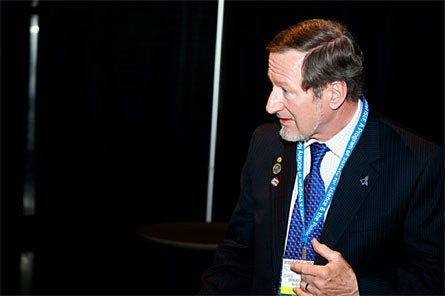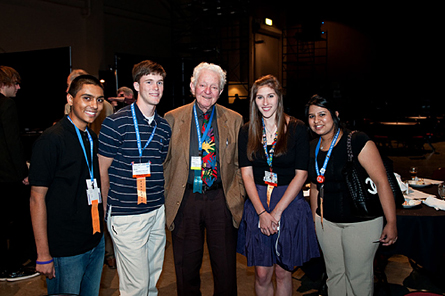- More than 2 years ago
RENO, Nev. — In a ceremony that’s referred to as “the passing of the torch,” hundreds of high school science students took part in a Q and A with a panel of Nobel laureates and distinguished scientists May 12. A more fitting title might be “the passing of the Bunsen burner or mass spectrometer.”


Eight giants of science offered advice to the packed auditorium during this year’s Intel International Science and Engineering Fair, which has almost 1,600 participants.
Emceed by National Public Radio science correspondent Joe Palca, the Q-and-A session ranged from the nitty-gritty of renewable energy to the more philosophical, such as the role the arts in a scientist’s career.
Student Philip Streich, an ISEF finalist and third-place winner of the 2009 Intel Science Talent Search, kicked off the event by asking how the panel defined creativity and how that quality is best fostered. Kurt Wüthrich, who shared the 2002 Nobel Prize in chemistry for his development of nuclear magnetic resonance spectroscopy, likened creativity to originality. “A simple rule I use in my lab is if we can’t buy the software, we must be near the frontier,” he said. “If the software is there, we better be careful.”
Student Terrence George, also an ISEF finalist, asked about the role of imagination in science, which prompted some quibbling among the panel. Jocelyn Bell Burnell, whose work led to the discovery of pulsars, said imagination is as important as the strictness of the scientific method. “We need the rigorous testing, but we also need creativity, wild ideas that are off the wall, because that’s where hypotheses come from in the first place.” Wüthrich then added a cautionary note: “Imagination can have its dangers,” he said. Scientists can get too attached to an idea they’ve imagined. “I would replace [imagination] with curiosity.”
Dudley Herschbach — who shared the Nobel Prize in chemistry in 1986 and chairs the board of trustees for Society for Science & the Public, publisher of Science News and administrator of the science fair — said that both imagination and curiosity are important. “Of course you need both — but beyond that you need a passion. You get unreasonably excited and possessed by a question — provided that it is a good question.”
Student and ISEF finalist Shuang Xu asked the scientists on the panel whether they think humanlike species exist beyond Earth, prompting a range of replies. Herschbach suggested the question should be sharpened, saying that, “for example, dolphins are humanlike; their intelligence has been established by research. I can imagine that there are dolphins out there.”
Douglas Osheroff, who shared the 1996 Nobel in physics for the discovery of superfluidity in helium-3, said he did not believe humanlike life was out there, but because of time, rather than place. Given that “humans are as destructive as we are, we will probably only live a very short time…. So it is not just a matter of the number of planets, but of time.” To which Herschbach replied: “But dolphins have been here 50 million years.”
Bell Burnell, whose 1967 detection of a rapidly rotating neutron star was originally dubbed “Little Green Man 1,” had a more practical comment. “How will we approach and consider other signs of life in the universe?” she asked. “These are tough decisions.… Will we approach them as dangerous? Will we approach them as peaceful? Will we put them in a zoo? Eat them? Send in the GIs to bring them democracy?”
Student and finalist Taylor Trew asked the panel members whether any had artistic talent and if that talent had helped in their scientific endeavors. Martin Chalfie, who shared the 2008 Nobel in chemistry for work on green fluorescent protein, said his father, a professional guitarist, gave him a classical guitar at age 12. “I still enjoy it immensely,” Chalfie said. “It is a great way to relax … and to balance everything.” Osheroff, citing his love of poetry, noted the importance of backing away from science and refreshing with the arts. He then recited from memory the cowboy poem “Reincarnation” by Wallace McRae.
Herschbach was asked by student and finalist Isabel Bosque whether his experience as an Eagle Scout helped him in his life as a scientist. “Science is a very social enterprise,” he said, as was the scout experience. Peter Agre, who shared the chemistry Nobel in 2003 for his discovery of aquaporins, said the Boy Scouts allowed him to experience nature and the wilderness. Chalfie, who was not a scout, pointed out that many of the students’ questions included a disguised version of the question, “What does it take to be successful?” “In each case, we are an ‘n’ of one,” he said. “I don’t think there is a path…. I don’t think that life is that deterministic. But if you delve into something, that is important.”
Panel members were also asked what scientific topics society commonly overlooks. Leon Lederman, who shared the physics Nobel in 1988 for work with neutrinos, said education was most overlooked. He received resounding applause.
Agre added: “Being a scientist is a hell of a lot of fun.”







